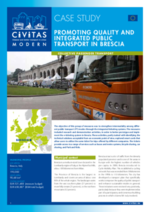
Brescia (Italy)
The Italian city of Brescia lies at the foot of the Alps and is with 190,000 inhabitants and 90.7 km² the second largest city in the Lombardy region. The city is suffering from high levels of congestion and pollution.
The city of Brescia was founded at the crossroads of numerous cultural and commercial roads as early as the Bronze Age. What started as a pastoral Ligurian settlement gained importance in Roman times as the capital of the Gallic Cenomani. Brescia’s ancient city centre was partially destroyed during the Second World War but preserved its original Roman urban structure and several ancient buildings. Many tourists are also drawn to the city for its proximity to Lake Garda in summer and to the Alps in winter. Brescia is also an important industrial centre, well-known as the main producer of reinforced concrete rod and its role in arms manufacturing.
Brescia attracts a lot of traffic from the densely populated province and is one of the European areas with the highest number of vehicles per inhabitants. Pollution from the huge amount of traffic is high on the political agenda. In 2000, Brescia introduced its Cycle Mobility Plan. It established a cycling network that was extended from 30 km in the ‘90s to 115 km. The city also develops an Urban Mobility Plan for the development of the transport system that specifically targets the improvement of the quality of public transport and the conditions for sustainable modes in general.
The public transport system has been complemented with a light metro line for which constructions began in 2005, and a high mobility line (LAM) that consists of three ecological bus services connecting the city. The dedicated LAM lines that enjoy priority at traffic lights can also be used for cycling. Traffic calming measures were introduced to improve safety and encourage more cycling. These initiatives were received very positively, also because they were implemented as part of a participatory and consensus-building process where citizens felt they were truly involved.
With the participation in CIVITAS MODERN, Brescia wants to upgrade its efforts to tackle its mobility challenges. The project offers the city the opportunity to add to the already defined actions with a set of integrated measures. Transport policies need to be redefined to make the most of the new metro line. This requires for instance an integrated interchange policy that is crucial to reduce car circulation. Mobility management and more flexible transport options will contribute to release congestion. More people switching to public transport, the expansion of cleaner vehicles in the public transport fleet and encouraging citizens to use less polluting fuels will be crucial to curb levels of pollution.
Another focal point as part of MODERN will be to diffuse a culture of sustainable mobility, especially targeting schools, and developing mobility management for at least 20 companies. Within the project period, the modal share of public transport is projected to grow by 5 percent, while the share of private cars in the city centre should drop by 5-7 percent. The extension of bicycle lanes by 100 km and 40 percent more bicycle racks for people to park their bikes is anticipated to increase the number of cyclists by 3 percent.















